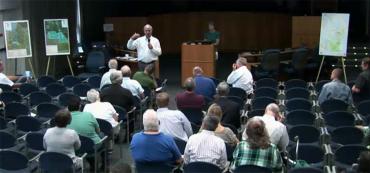
Quick-stepping on work that will bring the Everglades the reservoir mandated in 2017's Senate Bill 10, the South Florida Water Management District released preliminary modeling Monday that depicts South Florida's current water storage and conveyance capabilities.
This baseline modeling is the necessary first step in quantifying which alternative storage feature configuration south of Lake Okeechobee offers the greatest benefit to reducing harmful lake discharges to estuaries east and west. The most logical configuration will ultimately become the Everglades Agricultural Area (EAA) Storage Reservoir Project.
This baseline modeling, which factors in 41 years of weather events ranging from drought to extreme rainfall, is part of the extensive ongoing public review process for the EAA Storage Reservoir Project, which began as SB 10.
"We have been moving swiftly, but methodically, to make this project a reality following the scientific process," said SFWMD Federal Policy and Coordination Bureau Chief Matt Morrison. "The next key step is to establish the baseline performance of all other projects currently being built. This will help us better determine the benefits that proposed project alternatives for the EAA Reservoir project will add to the baseline. This modeling is the 'foundation' for evaluating all Comprehensive Everglades Restoration Plan projects."
The baseline modeling assumes the completion of other approved restoration projects now under way, such as the C-44 and C-43 reservoirs and the Central Everglades Planning Project (CEPP). The modeling shows these projects would likely reduce the number of months with potentially damaging releases to the St. Lucie Estuary by 50 percent and the number of months of damaging releases to the Caloosahatchee River and Estuary by 30 percent. Once complete, the EAA Reservoir project would add to the overall reduction numbers for both estuaries.
"Moving forward, the District will use this baseline modeling to examine potential project features of the EAA Reservoir project to determine which features add the most benefit and make the best use of taxpayer dollars," Morrison said.
At the meeting, District staff also fielded questions regarding other features that might be included in the reservoir project, such as stormwater treatment areas (STAs), constructed wetlands that use plants to remove excess nutrients such as phosphorus and nitrogen from stormwater. Based on preliminary estimates, SFWMD Modeling Section Administrator Walter Wilcox estimated that a reservoir designed to hold between 240,000 and 360,000 acre-feet (as SB 10 calls for) would likely need to be accompanied by 6,000-9,000 acres of STAs.
"A combination of reservoir storage and STAs as CERP envisioned provides a project best able to improve estuary and Everglades conditions," Wilcox said. "As illustrated in Central Everglades planning, configurations that rely solely on STAs can run out of water during drier conditions."
SFWMD is currently engaged in an extensive series of public meetings to receive public input that helps inform the scope and modeling for the project. Four public meetings have been conducted with at least three more scheduled for Nov. 15-16. This protocol is consistent with the National Environmental Policy Act (NEPA) review process necessary to ensure the project remains eligible for federal cost sharing.
For the modeling data and more information on the meetings, including agendas and presentations, click here.


